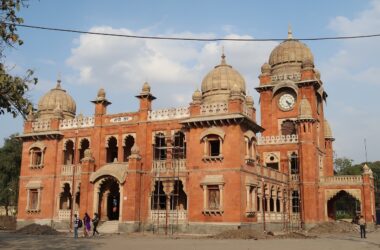Sri Padmavathi Ammavari Temple, also known as Alipiri Padmavathi Temple, is a Hindu temple located in the small town of Tiruchanur in the Indian state of Andhra Pradesh. The temple is dedicated to the goddess Padmavathi, who is considered to be the consort of Lord Venkateswara, one of the most revered deities in Hinduism.
The temple’s history can be traced back to the 9th century AD, when it was believed to have been built by the Eastern Chalukya king, Bhima. However, it was later renovated and expanded by the Vijayanagara kings in the 16th century. The temple is known for its intricate carvings and beautiful architecture, which is a blend of the Dravidian and Vijayanagara styles.
One of the most notable features of the Temple is its main gopuram, which stands at a height of 50 feet and is adorned with intricate carvings of various Hindu deities. The temple also has a beautiful mandapam, which is decorated with colorful frescoes depicting scenes from Hindu mythology.
The temple is also an important pilgrimage site for devotees of Lord Venkateswara, as it is believed that praying to Padmavathi at this temple will help to fulfill their desires and grant them blessings. The temple is particularly crowded during the annual Brahmotsavam festival, which is celebrated in the month of September and attracts thousands of devotees from all over the country.
In addition to its religious significance, the Temple is also an important tourist attraction in Andhra Pradesh. Visitors can admire the temple’s beautiful architecture and learn about the rich cultural and historical heritage of the region.
Overall Temple is a must-visit for all the devotees of Lord Venkateswara and for those who are interested in the rich cultural and historical heritage of Andhra Pradesh.
Facts about Sri Padmavathi Ammavari Temple
- Sri Padmavathi Ammavari Temple is a Hindu temple located in the small town of Tiruchanur in the Indian state of Andhra Pradesh.
- The temple is dedicated to the goddess Padmavathi, who is considered to be the consort of Lord Venkateswara.
- The temple’s history can be traced back to the 9th century AD, when it was believed to have been built by the Eastern Chalukya king, Bhima.
- The temple is known for its intricate carvings and beautiful architecture, which is a blend of the Dravidian and Vijayanagara styles.
- The temple’s main gopuram stands at a height of 50 feet and is adorned with intricate carvings of various Hindu deities.
- The temple is an important pilgrimage site for devotees of Lord Venkateswara.
- The temple is particularly crowded during the annual Brahmotsavam festival, which is celebrated in the month of September.
- The temple is also an important tourist attraction in Andhra Pradesh, attracting visitors to admire its beautiful architecture and learn about the rich cultural and historical heritage of the region.
- The temple is located in the heart of the city of Tirupati, which is well connected by road, rail, and air.
- The temple is open from early morning till evening and entry is free for all.
How to reach Sri Padmavathi Ammavari Temple
The Temple is located in the small town of Tiruchanur, which is situated just 5 kilometers away from the city of Tirupati in the Indian state of Andhra Pradesh. The temple is well connected by road, rail, and air, making it easily accessible for devotees and visitors.
By Road: Tiruchanur is well connected to major cities in Andhra Pradesh and Tamil Nadu by a network of state and national highways. There are regular bus services from Tirupati, Chennai, and other major cities in the region. Taxis and private vehicles are also available for hire.
By Train: The nearest railway station to Tiruchanur is Tirupati Railway Station, which is located about 5 kilometers away. The station is well connected to major cities in India and there are frequent trains to and from Tirupati.
By Air: The nearest airport to Tiruchanur is Renigunta Airport, which is located about 15 kilometers away. The airport is well-connected to major cities in India, with regular flights to and from Tirupati.
Once you reach the city of Tirupati, you can easily reach the temple by taking a bus or a taxi. The temple is located in the heart of the city and is well-signposted, making it easy to find.
Similar Articles
Frequently Asked Questions About Sri Padmavathi Ammavari Temple
Q. What is the significance of the Sri Padmavathi Ammavari Temple?
A – The Sri Padmavathi Ammavari Temple is considered an important pilgrimage site for devotees of Lord Venkateswara, as it is believed that praying to Padmavathi at this temple will help to fulfill their desires and grant them blessings.
Q. What is the history of Sri Padmavathi Ammavari Temple?
A – The temple’s history can be traced back to the 9th century AD, when it was believed to have been built by the Eastern Chalukya king, Bhima. However, it was later renovated and expanded by the Vijayanagara kings in the 16th century.
Q. What are the timings of Sri Padmavathi Ammavari Temple?
A – The temple is open from early morning till evening, generally from 4:00 am to 8:00 pm.
Q. Is there an entry fee to visit Sri Padmavathi Ammavari Temple?
A – There is no entry fee to visit the temple.
Q. Is photography allowed inside Sri Padmavathi Ammavari Temple?
A – Photography inside the temple is generally allowed, but with restrictions as per the temple’s rules. It is best to check with the temple authorities before taking any photographs.
Q. What is the best time to visit Sri Padmavathi Ammavari Temple?
A – The temple is always open and is always crowded with devotees, but the best time to visit the temple is during the Brahmotsavam festival which is celebrated in the month of September and attracts thousands of devotees from all over the country.
Q. Are there any facilities for accommodation near Sri Padmavathi Ammavari Temple?
A – There are several options for accommodation in and around Tirupati, including hotels, lodges, and guesthouses. Additionally, the TTD runs guest houses and cottages for accommodation.









